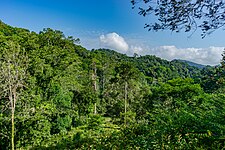Amani Nature Reserve
| Amani Forest Reserve | |
|---|---|
IUCN categoryIV (habitat/species management area) | |
 Amani Forest Reserve | |
| Location | KorogweandMuhezaofTanga Region, |
| Nearest city | Muheza |
| Coordinates | 5°05′S38°40′E/ 5.083°S 38.667°E |
| Area | 83.04 km2(32.06 sq mi) |
| Designation | Nature Forest Reserve |
| Established | 1997 |
| Named for | Amanimeans Peace inSwahili |
| Governing body | Tanzania Forest Service Agency (TFS) under theMinistry of Natural Resources and Tourism |
| Website | Official Page |
TheAmani Forest Reserve,officially listed asAmani Nature Forest Reserve(Msitu wa Akiba wa Amani,InSwahili) is aprotected arealocated theMuhezaandKorogwe Districtsin theTanga RegionofTanzania.Thenature reservewas established in 1997 in order to preserve the uniquefloraandfaunaof the EastUsambara Mountains.The East and West Usambara Mountains are abiodiversity hotspot.The Amani Nature Reserve includes tropicalcloud foresthabitats.[1]
Amani is home toAfrican violet(Saintpaulia), which are thought to have a spiritual component (power of forgiveness) to the nativeShambaa people,has enormous ecological value in the Amani ecosystem. The region is listed as one of the top 12 bird-watching locations in the world byBird Life International,and the Reserve is a recognized Man andBiosphereReserve byUNESCO.[2]
History
[edit]The Amani Nature Reserve was established in 1997 in a forested area in the East Usambara Mountains with an area of 83.8 km2(32 sq mi), including the Amani Botanical Garden of 3 km2(1.2 sq mi) and a further 10.7 km2(4.1 sq mi) of forest managed by local tea estates. Traditionally, people living in villages adjacent to the reserve have used the forest as a source of timber, firewood and medicinal plants, a place to gather plants, bush meat, honey and fruit for consumption and a source of live birds, amphibians, reptiles and invertebrates for international trade.[3][4]
Flora
[edit]The forests in the reserve have been described as intermediate evergreen forests or submontane evergreen forest, a type of vegetative cover that tends to grow on the seaward side of both the West and East Usambaras. The dominant trees areAllanblackia stuhlmannii,Isoberlinia scheffleri,Macaranga capensis,Cephalosphaera usambarensis,Myrianthus holstii,Newtonia buchananiiandParinari excelsa.[5]
A growing problem in the area is the presence of the invasive West African treeMaesopsis eminii.This tree germinates readily from seeds which are spread by birds, springs up in gaps in the canopy and outperforms native tree seedlings, displacing rare endemics and reducing biodiversity. The forests of East Usambara have long been separated from other forests and their isolation makes them more vulnerable to invasive species such asM. eminii.[6]
Fauna
[edit]
The fauna of the Usambara Mountains has been compared to that of theGalápagos Islandsin terms of its richness and biological importance. The area of the Amani Nature Reserve is better studied than many other parts of the range with numerous endemic invertebrates dependent on the native moist forest cover including mites, spiders, freshwater crabs, dragonflies, beetles, butterflies, millipedes and molluscs.[7]
There are few large mammals in the reserve.Duikerandbushpigare plentiful and there are two species ofmonkey,but theelephantsandleopardsthat used to inhabit the area are no longer present.[5]The elusivelong-billed forest warbler(Artisornis moreaui) is known from the reserve and from one other locality,Mount Namuliin northern Mozambique, 1,000 km (600 mi) away.[8][9]
Some of the endemic animals are named after the mountains in which the nature reserve is set, and these include theUsambara weaver(Ploceus nicolli),Usambara akalat,Usambara hyliota(Hyliota usambara) and theUsambara eagle-owl(Bubo vosseleri). Others are named after the reserve, and these include theAmani sunbird(Hedydipna pallidigaster) and theAmani tailorbird.There are also endemictree frogsandchameleonsunique to the area.[10]
Amani Hill Research Station
[edit]Founded in 1902, after World War II the scientific station became famous for its research intomalaria.Since the 1970s the laboratory has remained largely unchanged with the specimens and instruments of a long gone by era. As of 2017 the station receives few visitors and the thirty-four staff maintain theentomological collectioncontinuing to add butterflies and other insects.[11]
Attractions
[edit]The reserve is endowed with a variety of tourist attractions in addition to Saintpaulia flowers, including endemic species of flora and animals, Unique biodiversity, natural features, and historical and cultural attractions. The reserve is renowned for its diverse bird andbutterflyspecies.[12]
See also
[edit]References
[edit]- ^"Amani Nature Forest Reserve".Tanzania Forest Service Agency.
- ^"Amani Nature Forest Reserve".Tanzania Forest Service Agency.
- ^Roe, Dilys (2002).Making a Killing Or Making a Living: Wildlife Trade, Trade Controls, and Rural Livelihoods.IIED. p. 61.ISBN978-1-84369-215-7.
- ^Mpanda, Mathew M., et al. "Impact of forestland tenure changes on forest cover, stocking and tree species diversity in Amani Nature Reserve, Tanzania." Forests, Trees and Livelihoods 20.4 (2011): 215-229.
- ^abHamilton, Alan Charles; Bensted-Smith, R. (1989).Forest Conservation in the East Usambara Mountains, Tanzania.IUCN. pp. 32, 83.ISBN978-2-88032-965-5.
- ^Hamilton, Alan Charles; Bensted-Smith, R. (1989).Forest Conservation in the East Usambara Mountains, Tanzania.IUCN. p. 12.ISBN978-2-88032-965-5.
- ^Hamilton, Alan Charles; Bensted-Smith, R. (1989).Forest Conservation in the East Usambara Mountains, Tanzania.IUCN. pp. 350–352.ISBN978-2-88032-965-5.
- ^BirdLife International (2018)."Artisornis moreaui".IUCN Red List of Threatened Species.2018:e.T103771879A129556131.doi:10.2305/IUCN.UK.2018-2.RLTS.T103771879A129556131.en.Retrieved12 November2021.
- ^Philip Briggs (2009).Northern Tanzania: With Kilimanjaro and Zanzibar.Bradt Travel Guides. p.21.ISBN978-1-84162-292-7.
- ^"Amani Nature Reserve".Amani Forest Camp.Retrieved24 January2016.
- ^Whyte, Chelsea (27 May 2017). "Aperture – Reaching into the past".New Scientist.No. 3127. pp. 26–7.
- ^Scurrah-Ehrhart, Cecilia, and Tom Blomley. "Amani butterfly forest-based enterprise, Tanga, Tanzania." Rights and Resources, unpublished paper (2006).

